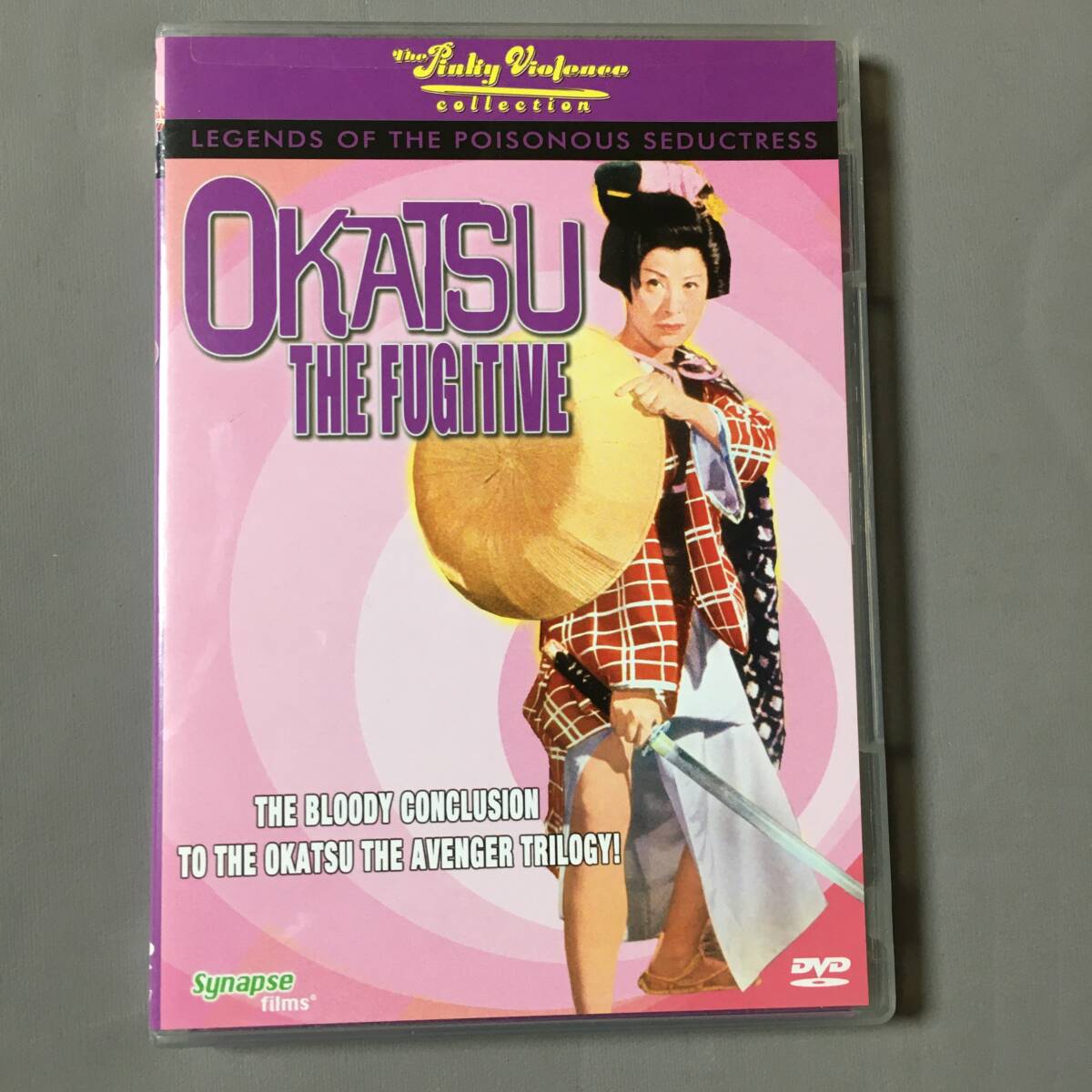In the final episode of the LEGENDS OF THE POISONOUS SEDUCTRESS series, Junko Miyazono appears one final time as beautiful swordswoman Okatsu the Avenger, but this time seeking Judayu, a corrupt merchant responsible for the death of her parents. Betrayed by her fianc, Okatsu finds herself aided in her quest by a handsome 5493030679 6 stranger (yakuza film star Tatsuo Umemiya) - who happens to be as handy with a sword as she is! What is the reason for his kindness, and will Okatsu be able to prevail against Judayu, now a powerful lord with scores of allies in high places? Whatever the end may be, the restless spirits of her murdered parents drive OKATSU THE FUGITIVE along her crimson-colored road of vengeance. Master filmmaker Nobuo Nakagawa (Jigoku, Snake Woman's Curse) brings audiences the stunning end of the trilogy that inspired countless imitators among Toei's Pinky Violence films of the 1970s.
Be sure to collect the other two volumes in the LEGENDS OF THE POISONOUS SEDUCTRESS series - FEMALE DEMON OHYAKU and QUICK-DRAW OKATSU for more action-packed female swordplay excitement!
—
SPECIAL FEATURES:
New, fully restored anamorphic widescreen transfer mastered in high-definition from Toei's original vault elements
Japanese language with newly-translated, removable English subtitles
Nobuo Nakagawa poster gallery and biography
Original trailers for all three POISONOUS SEDUCTRESS films
Printed essay on female swordplay cinema by Chris D.
Reversible cover with original Japanese poster artwork
TOEI CO., LTD. PRESENTS LEGENDS OF THE POISONOUS SEDUCTRESS: OKATSU THE FUGITIVE (YOEN DOKUFU-DEN: OKATSU KYOJO TABI)
STARRING JUNKO MIYAZONO TATSUO UMEMIYA REIKO OSHIDA YOICHI NUMATA PHOTOGRAPHY BY YOSHIKAZU YAMASAWA MUSIC BY KOICHI KAWABE
SCREENPLAY BY KOJI TAKADA & HIDEAKI YAMAMOTO DIRECTED BY NOBUO NAKAGAWA Program Content 1969 Toei Co., Ltd. All Rights Reserved. DVD Packaging Layout & Design 2007 Synapse Films, Inc. Color/1969/84Mins.
DODOLBY
WIDESCREEN 2.35:1/16:9
FBI ANTI-PIRACY WARNING
WARNING THIS MOTION PICTURE IS PROTECTED BY LAW. For sale or rental for private home use in the USA and Canada only. Federal law provides severe civil and criminal penalties for the unauthorized reproduction, distribution or exhibition of copyrighted motion pictures, videotapes or videodiscs.
Packaging Layout and Design by: FOUNDRY DESIGN LABS. www.foundrydesignlabs.com. All Rights Reserved. Dolby and the double-D symbol are trademarks of Dolby Laboratories Licensing Corporation. All Rights Reserved.
OKASU THE FUGITIVE
SCENE SELECTIONS
1. Cruelty & brutality 2. The Makabe family 3. Contraband tobacco
4. Water-torture
5. Rape and betrayal
6. Oath of vengeance 7. Okyo
8. Showdown at the brothel
9. Okatsu the Entertainer
DVD PRODUCTION CREDITS
Producer: Marc Walkow
10. Onsen intrigue 11. A mysterious stranger 12. The Inugami orphan-clan 13. Treachery in Numata 14. Burning of the temple 15. Shinzaburo's final disgrace 16. Castle assault 17. Confrontation
18. Demon of Revenge
Executive producers: Don May, Jr. and Gerald Chandler Package design: Foundry Design Labs (Christopher Lee)
DVD authoring: Radius60 Studios (Alex Webster, Keith Prokop)
Subtitles: JR Media (Kent Conrad, Matt Jansky, Rob Troy)
Video transfer supervised by Don May, Jr. at Ascent Media Burbank, telecine colorist David Block Digital restoration services: Screen Time Images, Schaumburg, IL
SPECIAL THANKS
Chris D., Kumi Ogata, Matt Kennedy, Nicholas & Tamami Rucka, Angie Bucknell & Fumiko Takagi/
The Criterion Collection, and Jennifer Lui.
Lady Avengers and Poisonous Seductresses: A Short History of the Japanese Female Swordplay Film
By Chris D.
What is the attraction of a woman with a sword? For women, this archetype represents a powerful image of identification pushed to its most potent distillation. Then there are the vicarious thrills of macho sadists having their private parts pierced by righteous lady avengers. But there's also a subtle eroticism -the sensual, beguiling charm of the Special Female, the Mother/Goddess, a Bringer-of-Life becoming a literal Death Harvester-and a more obvious sexuality, sometimes awkwardly coarse, yet sometimes beautiful, graceful, and awe-inspiring: a ravaged woman, suddenly possessed of near-superhuman strength, overcoming adversity.
As fanciful as female swordplay films became in their depiction of scantily-clad avengers mowing down scores of enemies, there was, believe it or not, a historical precedent to such imagery, as female warriors actually did exist long ago in Japan's history. One of the earliest records of a female fighter was Tomoe Gozen, circa 1080, by varying accounts either the spouse or the servant of Lord Yoshinaka Minamoto. In 1561, when warlord Moritoki Mochizuki perished in combat, his widow Chiyome was left under the protection of her late spouse's uncle, Lord Shingen Takeda, a man bent on conquering Japan. Spurred by Takeda's commands, Chiyome generated the first network of kunoichi or female ninjas. In the 1600's, decades after Takeda's assassination, female ninjas continued to serve in underground networks of the Iga and Koga clans. More recently, in the 1860's, Takeko Nakano and her female cohorts of Aizu province battled side by side with their male counterparts when Imperial troops invaded their domain in 1868. In 1876, women of the Satsuma clan fought alongside their male brethren in the Satsuma Rebellion, one of the last gasps of the samurai class before the carrying of a sword was outlawed in the modernist Meiji Era.
But how did these historical precedents affect the appearance of sword-wielding females in historical swordplay-type films? And how did that, in turn, blend with the sort of "bad girl cinema" that began in Japan in the mid-1950's, later mutated and was branded "Pinky Violence" in the mid-1960's, then reached its peak in the mid-1970's and has continued sporadically until the present day? Sword-wielding heroines and anti-heroines appeared on film as early as the silent era-OKATSU director Nobuo Nakagawa even helmed a two-part Woman Sazen series in 1937 with actress Komako Hara as a female variation of the one-eyed, one-armed lone wolf hero, Tange Sazen. But the first time women could be seen brandishing swords with any regularity wasn't until the late 1950's, in some of Shintoho Studios' samurai opuses, particularly in the performances of actress Misako Uji. Toei, Daiei and Shochiku Studios saw actresses Hibari Misora, Fujiko Yamamoto and Michiko Saga display swordplay in the rare one-off film, or, as in musical star Misora's case, various samurai and/or in-period yakuza musicals, all with merciful little connection to reality.
But in the mid-1960s, something odd, but not totally unexpected, began happening, and a weird Confluence of genres came together. The more socially and psychologically realistic pictures of filmmakers like Shohei Imamura and Yasuzo Masumura began to have an impact-even if, in many cases, a subliminal one on other directors. Gritty stories of Japanese women dealing with life on the street (bar hostesses, whores, teen runaways) began to appear. Actresses such as Mako Midori headlined in many films, including Two Bitches (Nihiki no mesu inu, 1964) and The Sex Peddlers (Himo, (CONTINUED ON INSIDE)
1965). Nikkatsu Studios pioneered knife-wielding female yakuza in the Cat Girl Gambling (Mesu neko bakuchi trilogy (1965-1966), helmed by Seijun Suzuki's mentor, Hiroshi Noguchi, and starring Yumiko Nogawa. And in 1966, Daiei studios inaugurated their long-running Woman Gambling Expert (Onna tobakushi series starring the underrated Kyoko Enami.
A watershed year for the depiction of women yakuza of the ninkyo, or chivalrous, variety came in 1968, most prominently with Toei Studios' well-received Red Peony Gambler (Hibotan bakuto) pictures, starring Junko Fuji. Their success caused an outburst of female yakuza and samurai cinema from all the studios. Daiei emerged with the Kanto Woman (1968-1969) quartet of yakuza films and the lesser-known female samurai One-Eyed, One-Armed Swordswoman (Onna Sazen, 1968-1969) duo, all starring Michiyo Yasuda. Yasuda also starred in several of the in-period Secrets of a Women's Prison (Hiroku onna-ro, 1968-1971) films.
Shochiku melded elements from the Zatoichiand Red Peony Gamblerseries to produce Yoko Matsuyama as the sword-brandishing, blind Oichi, The Crimson Bat (Mekura no Oichi, in four pictures from 1969 to 1970. 1969 was also the year that Nikkatsu Studios showcased singer Hiroko Ogi in the Rising Dragon (Nobori ryu) and Vermillion Sword Scabbard Code (Shuzaya jing films. There were several other one-offs at Nikkatsu from 1968 through 1970 starring the likes of Ogi and Meiko Kaji (Kaji most memorably in Blind Woman's Curse, director Teruo Ishii's ero-guro-inflected final installment of the Rising Dragon trilogy).
Junko Fuji branched out into other offerings in 1969, including the two Chivalrous Woman (Onna toseinin films, both of which showcased heavy sword action. Before Fuji retired from the screen in 1972 to get married, her last picture at Toei was the all-star ninkyo movie Cherry Blossom Fire Gang (Kanto hizakura ikka). Toei immediately tried to hit sword-wielding female paydirt again, first with Kyoko Enami in Tai Kato's excellent Showa Woman Gambler (Showa onna bakuto, 1972), then with the late Eiko Nakamura in Teruo Ishii's bloody Pinky Violence period epic The Red Silk Gambler (Hichirimen bakuto, 1972). Toei's resident delinquent girl, Reiko Ike, gave it a try in 1973 in the gonzo duo of Elder Sister (Anego-den) films directed by Norifumi Suzuki (Sex and Fury) and Teruo Ishii (Female Yakuza Tale). But despite all being extremely entertaining tall tales, none caught fire at the box office.
Stray Cat Rock star Meiko Kaji did a more contemporary take on the yakuza heroine, mixing elements from the sukeban (delinquent girl boss) genre of films in director Kazuhiko Yamaguchi's two Ginjo, or Wandering Silver Butterfly movies in 1972. The following year saw Toho Studios draft Kaji for director Toshiya Fujita's early 20th century pair of Lady Snowblood (Shura yuki-hime) pictures adapted from Kazuo Koike's manga, and the revenge saga featured plenty of blood-spurting swordplay (as already seen in Koike's Lone Wolf and Cub sextet of films-which maintained their own quota of fierce swordswomen).
1968 was certainly the year the new phenomenon took hold, mixing bad girl cinema with erotic/grotesque, or ero-guro, elements. Director Teruo Ishii was partly responsible for this with the success of his period-set, cinema-of-cruelty "Joys of Torture" films that were an amalgam of nudity, surreal scenarios and bloody viscera. Nevertheless, it wasn't until 1972 that the extreme violence, high blood quotient and widespread nudity began to fully integrate themselves into most studios' genre film output.
In 1968, taking a cue from not only Ishii's bloody experiments and the swordplay-filled Red Peony Gambler series, but also Daiei's Secrets of a Women's Prison films, Toei produced a trilogy of female samurai pictures with Grand Guignol, ero-guro elements, the LEGENDS OF THE POISONOUS SEDUCTRESS
(Yoen dokufu-den) series. Today, the eroticism of the trilogy seems fairly mild when compared with what would come only a few years later, but the grotesque trappings of violence manifested themselves in gory glory. To helm the trio, Toei recruited two veterans from Shintoho Studios' 1950's heyday: Nobuo Nakagawa and Yoshihiro Ishikawa. Nakagawa, who directed the second and third pictures, was not only an unsung master of sword-swinging chanbara thrillers, but was also the patriarch of the Japanese horror film. Ishikawa, who oversaw the first entry, had directed his own films at Shintoho but had, more tellingly, also been Nakagawa's assistant director on the majority of his most lauded films, including Tokaido Yotsuya kaidan.
OKATSU THE FUGITIVE, like its two predecessors, seems an old-fashioned tale. But the chanbara and horror films Nakagawa and Ishikawa had made at Shintoho were ground-breaking, taboo-smashing benchmarks in Japanese genre cinema. Like Shintoho comrade Ishii, they were ahead of their time and experts at upgrading old-fashioned cliffhanger plots into more perversely sophisticated scenarios, brimming with sadistically phantasmagorical visuals.
Lead Junko Miyazono was one of the unsung actresses of Japanese genre cinema, often given thankless supporting roles as the girlfriend or wife in numerous Toei samurai and yakuza films, yet able to effortlessly give off an aura of intelligence, sensual beauty, and steely resolve when given the chance to carry a feature. And like many other Japanese genre film actresses who were working right on the cusp of a more explicit age, Miyazono never fully disrobed onscreen. Tatsuo Umemiya makes his first appearance in the series as the ronin-with-a-dark-past Inugami, but was a veteran of scores of yakuza films as well as the comic Delinquent Boss (Furyo bancho) movies. Three familiar faces make up the worst villains here: Toru Abe and Hiroshi Nawa were typecast as bad guys in countless yakuza, samurai, and Pinky Violence pictures, and appear here as Judayu and as Okatsu's treacherous swordmaster; Yoichi Numata, who plays murderous enforcer Daizen, was an old hand at scoundrel roles while at director Nakagawa's former Shintoho stomping grounds, including a classic turn as the demonic Tamura in Nakagawa's horror masterwork Jigoku (1960). On the side of the good guys, Delinquent Girl Boss (Zubeko bancho) star Reiko Oshida returns from the previous Okatsu entry, but with much less to do (and no sword in sight).
OKATSU THE FUGITIVE's story has conspicuous similarities to its immediate predecessor-Miyazono is called Okatsu, but she is not the same character, and while this Okatsu is still proficient at swordplay, her father is a government official this time. In addition to her sensei, her fianc also betrays her here, but there the main distinctions end. Nakagawa instead works a variation on a theme, again using the vendetta formula as a jumping-off point. Once more someone called Okatsu has her father (and this time, also her mother) tortured to death, and following the ero-guro dictates of the series, Nakagawa then plunges her into the depths of hell. As in Quick-Draw Okatsu, Nakagawa shifts between a subjec- tive and an omniscient viewpoint, but his virtuoso style is a bit less in evidence the shooting schedule seems to have been slightly more hurried, the budget slightly lower. Nevertheless, there is much excit- ing swordplay here-viewing the film's abstract title sequence, where Okatsu demonstrates her fenc- ing skills, one cannot help but be reminded of the many Chinese wuxia female swordplay epics then in release, such as King Hu's Come Drink With Me. And when one watches the phantasmagoric climax at the evil magistrate's drowning pit, it's strongly reminiscent of the unbridled 'bad trip' psychedelia of Nakagawa's most famous descent into madness, Jigoku.
Chris D. is author of the recently-published OUTLAW MASTERS OF JAPANESE FILM as well as the upcoming GUN AND SWORD: AN ENC故障品(垃圾品)、問題商品、可能無法修理,請注意YCLOPEDIA OF JAPANESE GANGSTER FILMS 1955-1980, and also works as a programmer at the American Cinematheque in Los Angeles. His first feature film as director, PASS FOR HUMAN, was released on DVD in late 2006.



















 好評 (0)
好評 (0)  (0)
(0)


 Line線上客服
Line線上客服 FB粉絲團
FB粉絲團
